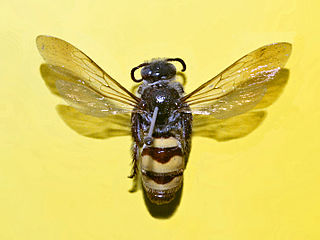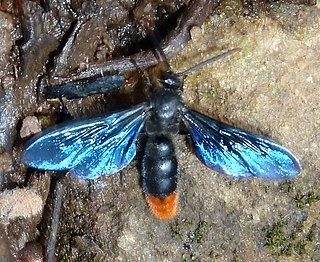
The Scoliidae, the scoliid wasps, are a family of wasps comprising about 560 species worldwide. They tend to be black, often marked with yellow or orange, and their wing tips are distinctively corrugated. Males are more slender and elongated than females, with significantly longer antennae, but the sexual dimorphism is not as apparent as in many of the Tiphiidae and Thynnidae.

Carpenter bees are species in the genus Xylocopa of the subfamily Xylocopinae. The genus includes some 500 bees in 31 subgenera. The common name "carpenter bee" derives from their nesting behavior; nearly all species burrow into hard plant material such as dead wood or bamboo. The main exceptions are species in the subgenus Proxylocopa, which dig nesting tunnels in suitable soil.

Polistes is a cosmopolitan genus of paper wasps and the only genus in the tribe Polistini. Vernacular names for the genus include umbrella wasps, coined by Walter Ebeling in 1975 to distinguish it from other types of paper wasp, in reference to the form of their nests, and umbrella paper wasps. Polistes is the single largest genus within the family Vespidae, with over 200 recognized species. Their innate preferences for nest-building sites leads them to commonly build nests on human habitation, where they can be very unwelcome; although generally not aggressive, they can be provoked into defending their nests. All species are predatory, and they may consume large numbers of caterpillars, in which respect they are generally considered beneficial.

The Tiphiidae are a family of large, solitary wasps whose larvae are parasitoids of various beetle larvae, especially those in the superfamily Scarabaeoidea. Until recently, this family contained several additional subfamilies, but multiple studies have independently confirmed that these comprise a separate lineage, and are now classified in the family Thynnidae.

Anthia is a genus of the ground beetle family (Carabidae) from Africa and Asia. Species of Anthia can spray a jet of formic acid up to 30 centimetres (12 in), which, if not treated, can cause blindness in animals that harass the beetles.

Amata is a genus of tiger moths in the family Erebidae. The genus was erected by Johan Christian Fabricius in 1807.

Megascolia procer, the giant scoliid wasp, is a solitary wasp in the family Scoliidae found across Asia. It is one of the largest wasps in the world, with a wingspan of 11.6 cm (4.6 in).

Scolia is a genus of scoliid wasps in the subfamily Scoliinae. There are over 200 described species in Scolia.

Phytoecia is a genus of longhorn beetles of the subfamily Lamiinae,

Lithurgus is a genus of bees in the family Megachilidae.

Hyptia is a genus of ensign wasps in the family Evaniidae. There are at least 50 described species in Hyptia. Most Hyptia can be differentiated from other genera by heavily reduced venation of the forewings, wherein only one closed cell is present.

Dielis is a New World genus of the family Scoliidae, also known as the scoliid wasps.

Campsomerini is a cosmopolitan tribe of the family Scoliidae. An older, alternative representation of this group is as a subfamily, Campsomerinae.

Scoliini is a cosmopolitan tribe of the family Scoliidae.

Dusona is a genus of parasitoid wasps belonging to the family Ichneumonidae. It is the most species rich genus of the subfamily Campopleginae with 442 known species.

Pyrrhoscolia is a genus of scoliid wasps in the subfamily Scoliinae. It is native to the Afrotropics, where they have been recorded in various Afromontane regions. They are external parasitoids of beetle larvae. The wings of all three species are noted for their brilliant lustre.
















